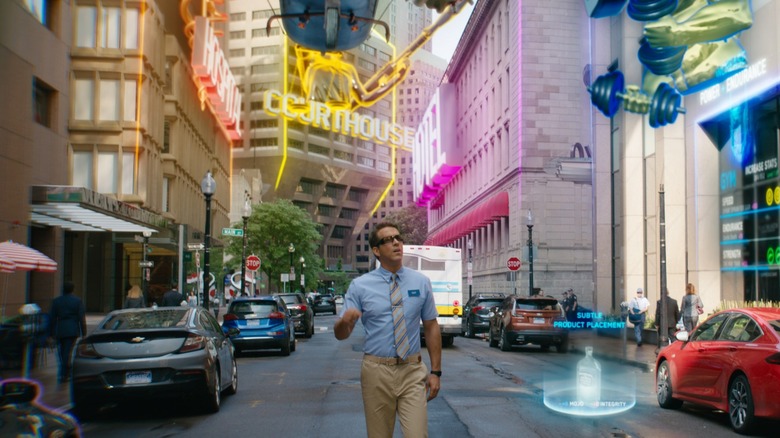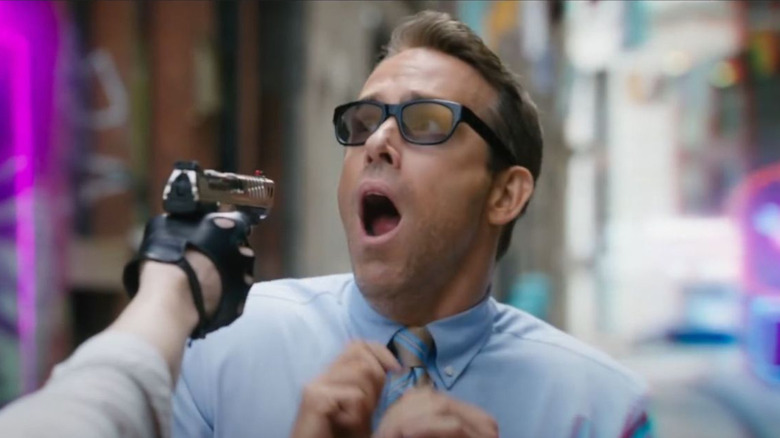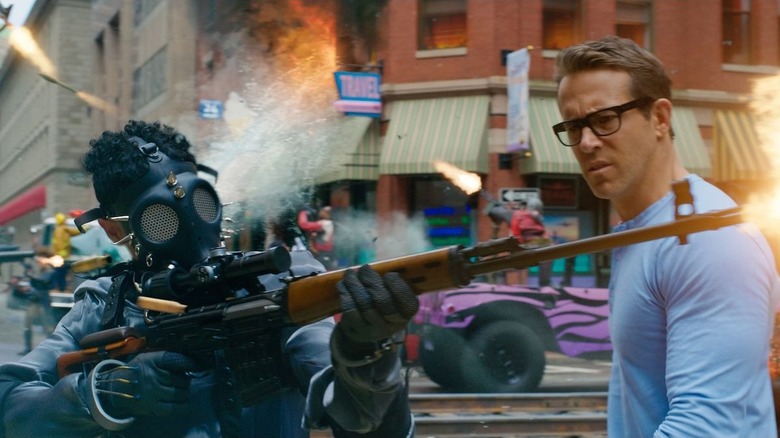Free Guy Producer Designer Ethan Tobman Couldn't Avoid Grand Theft Auto [Interview]
The world of "Free Guy" is familiar to anyone who's played or ever seen a video game. The attention to detail, the pace of action, characters and life in a game, it's striking how close Shawn Levy's movie is to the experience of gameplay. Free City sticks close to the rules of a role-playing game, even when its lead character is breaking those rules. Production designer Ethan Tobman, who worked on "Lemonade" and the "All the Stars" video, is one of the artists responsible for bringing the original environment to life.
Before Tobman even got the job, he was letting his imagination run wild. The gamer continued to study video games, but for the vast swathe of the references for the 20th Century Studios movie, he looked at some unlikely inspirations, including photographs from the great Nan Goldin. "Free Guy" is a movie with many obvious influences, but Nan Goldin is not one of them. Her photographs have a life-in-the-city style and rawness to them, and yet, they inspired Tobman.
For the Blu-Ray and digital release of "Free Guy," we spoke to Tobman about his influences in designing the world of "Free Guy," plus working on "Pam & Tommy."
"That's the process of creating art."
Before talking to Shawn Levy about "Free Guy," you did a month or two of sketching out ideas. What were those early ideas?
Oh, man. I mean, that was one of the most unique, free-spirited, and creatively rich months I think I've ever had working in film. I mean, the script was very strong and the idea was great. Shawn had a very clear vision of what he wanted to do, but at that moment, was bringing in Zak Penn, who's a world builder in his own right, to re-concept and re-approach some of the characters and some of the visuals. Shawn knew I was a gamer and he knew I had a lot of visual music videos under my belt. He said, "I'd like you to pitch sequences here to Zak that might end up becoming part of the script. And even if they don't, they might inspire something else."
So I got to hire a pre-viz company and create effect sequences, create story boarded sequences, before visual effects had ever started; before the script was even finished. Some of them made it into the movie. In particular, I pitched the idea of a highway or an avenue that a car is racing down with the buildings closing in, and Shawn loved it. And we did it. Who knows what that sequence ended up costing, but it was based off a one-sentence pitch and then a few days of drawing.
I spent two days with Zak when he was writing, pitching ideas. He's a video game expert, and we literally ended up playing games together, and again, creating this environment of best idea wins. PAs gave great ideas that ended up in the script. Actors gave ideas. Shawn is very much a person who's open to whoever ends up screaming out the thing that clicks, being the one who uses it. And yeah, in that month, I just looked at everything from gardens in Vietnam to rock formations in Iceland. They all made it into the movie.
You mentioned your background with the music videos. A video like "All The Stars," there's a lot of CG, obviously, in a video like that. How much does that affect your work? How much are you working with visual effects supervisors when designing?
It's a constant and very relevant question in the world I work in today. When do you know when to stop building and when do you hand it over? And also, who designs all of that extra elements that are created digitally? I'm a firm believer in, and I have a great relationship with, visual effects supervisors who embrace the idea that it starts with the production design, and then VFX runs with it. And of course, they flesh it out. They make it better. They add ideas. That's the process of creating art. But it does start in the art department and it often starts in me drawing.
So for example, in something like "All The Stars," or in an Ariana Grande video, "No Tears Left to Cry," or in "Formation" for Beyonce, there's a lot more being built than I think people realize. And then, visual effects will end up maybe copying it and repeating it, tweaking the angle. And that's why it ends up looking so real, is you're using real elements and you're employing them in 2.5D set extensions. When VFX is tasked with the task of building 3D completely from scratch, it puts a lot of pressure on them to create something real. It doesn't always sell to increasingly savvy audience eyes. So, I try to either build everything that I can, that they'll scan and use, or draw everything that I can that they'll end up animating and bringing to life.
"You can't not look at Grand Theft Auto."
What in "Free Guy" someone might assume is CGI but is not?
Whenever he's on the street, the first story is completely either built or dressed. When there's a burnt building, we ended up burning it up to the two-story mark, so that's 30 feet of building that's burnt down that's two blocks long. The train tracks are real. All the signage is real. But obviously, when he puts on his glasses, in a way you're handing it over to the Visual Effects Department to do phenomenal imaginative work.
Which video games did you look at for inspiration? Grand Theft Auto was one of them, right?
You can't not look at Grand Theft Auto. It's clearly the inspiration for a hyper-violent multi-platform game. But you're looking at it I think more to see what's been done and not to figure out what you're going to do. I think the reason the film is successful, both in terms of characters and empathy and also visuals, is we're really trying to create our own world. So I'm not looking to Grand Theft Auto so much to see the design as maybe, for example, we looked at the camera movements, because we're trying to imitate a video game.
So, it's not the city in the production design necessarily that we're looking at. For stuff like that I looked at everything from Nan Goldin photos of the '80s, Edward Hopper paintings. Stephen Shore parking lots, I'm looking at failed America and an America that's in some ways we still imagine America to be. And then, we're looking at video games more for the technical aspects of how to convince an audience that you're inside too.
As someone who was growing up around this time, I gotta ask, how was it recreating the world of "Pam & Tommy"?
I grew up around that time too. First of all, I cannot wait for people to see this. I think a lot of it's going to blow their minds, but what was so interesting to me about it is you don't realize you're living in a period of time when you're living in that period of time. It's only movies and theater and books and art that cause you, I think, to reflect on them in really empathetic ways. And I think of the '90s as a few years ago, but when you end up designing 1994 through 1997, you suddenly realize what a different world it was.
Payphones and tower records and sex tapes, not withstanding were also not used to the internet at that point in our culture. It's so funny to have people saying things like, "I used this internet thing called the web and I got four phone calls today from it." I mean, that was the way we felt that way as a culture. And the only other thing I'll say is, it's a much more complex socio-political observation of how we've changed as people, as a result of the internet than I think people are expecting.
I don't know what I can say, I know not very much, but it's definitely... When people inherit money very, or when people earn money very, very quickly, they make some very interesting choices. Tale as old as time.
"Free Guy" is now available on Blu-Ray.


